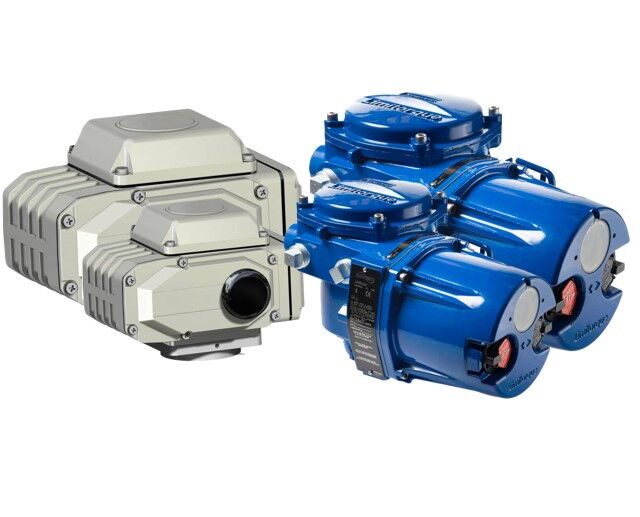Electric Actuators: Key Features, Advantages & Disadvantages
On this page
Electric actuators are critical devices widely used in industrial automation, offering numerous benefits. They provide high stability and consistent thrust while maintaining precise control under various complex conditions. Compared to hydraulic and pneumatic actuators, electric actuators exhibit unique advantages in certain applications. Below is an in-depth analysis of their main features, advantages, and disadvantages.
Electric actuators are characterized by their exceptional control accuracy, reliable operation, and highly integrated design. These features enable them to operate stably and efficiently even under challenging conditions.
Electric actuators provide a constant thrust or torque, allowing stable operation under various conditions. Their maximum thrust can reach up to 225,000 kgf, a leading figure in the field of electric actuators, typically achievable only by hydraulic actuators. However, hydraulic actuators are often more expensive, making electric actuators a more cost-effective choice when budget constraints exist.
Electric actuators can effectively counteract unbalanced forces in the medium, achieving precise control of process parameters. This gives them a clear control accuracy advantage over pneumatic actuators. When paired with a servo amplifier, electric actuators can easily switch between direct and reverse action and set valve positions (hold, fully open, or fully closed) in case of signal loss. In a fault state, electric actuators can automatically maintain their position, a feature that typically requires additional protection systems in pneumatic actuators.
Electric actuators are mainly classified into two types: part-turn and multi-turn. The multi-turn type is the most common, often used for operating large valves. It drives gears or worm gears with an electric motor, causing the valve stem nut to move the stem, thereby opening or closing the valve. These actuators are equipped with limit switches and torque sensors to protect the valve from damage. Part-turn actuators, on the other hand, are suitable for 1/4-turn (90-degree) movements, such as controlling ball and butterfly valves.
Modern electric actuators feature a highly integrated design, with all components housed in a waterproof, dustproof, and explosion-proof enclosure. This not only simplifies installation and maintenance but also significantly enhances device reliability. Basic integrated functions include position indication, torque protection, and manual operation devices, while advanced features enable remote monitoring and automated operation.
Electric actuators are widely used in industrial automation due to their numerous advantages. The following is a detailed analysis of their main strengths.
Electric actuators are driven by electricity, which is relatively easy to access. They offer fast signal transmission and long transmission distances, making them ideal for multi-point monitoring and remote operations in large industrial control systems.
Electric actuators can be paired with various electric control instruments, offering high sensitivity and precision. They can respond to control signals within a very short time and adjust valve positions accurately.
With all components housed within a single enclosure, electric actuators have relatively simple installation and wiring, making maintenance work easier.
Modern electric actuators can integrate multiple functions, such as fault alarms, self-diagnosis, and data logging. This makes them capable of standalone operation or seamless integration with intelligent control systems, achieving comprehensive automation control.
Despite their many advantages, electric actuators have certain limitations in specific applications. The following are their main drawbacks.
Compared to pneumatic and hydraulic actuators, electric actuators have a more complex structure, which can result in a higher average failure rate. Additionally, the electric motor is prone to overheating during frequent starts and stops, triggering thermal protection and affecting continuous operation.
Electric actuators have a slower response time compared to pneumatic and hydraulic actuators. It typically takes a longer time from receiving a control signal to completing valve movement. Therefore, they may not be suitable for applications requiring quick response, such as emergency shutdowns and rapid opening/closing operations.
While electric actuators provide stable thrust, their maximum thrust is still lower compared to hydraulic actuators. This limitation restricts their application in scenarios requiring extremely high thrust.
Electric actuators have higher requirements for power quality and environmental temperature. Their performance may be affected in extreme temperatures, and reliability may decrease in situations with unstable power supply.
Electric actuators, with their precise control capabilities, convenient energy access, and multifunctional integration, have become indispensable in modern industrial automation. Although they have certain limitations in response speed, structural complexity, and thrust capacity, they remain one of the best choices in scenarios requiring high-precision control, remote operation, and centralized management. Understanding the characteristics, advantages, and disadvantages of electric actuators is crucial for proper selection and application, contributing to overall system performance and operational efficiency.

